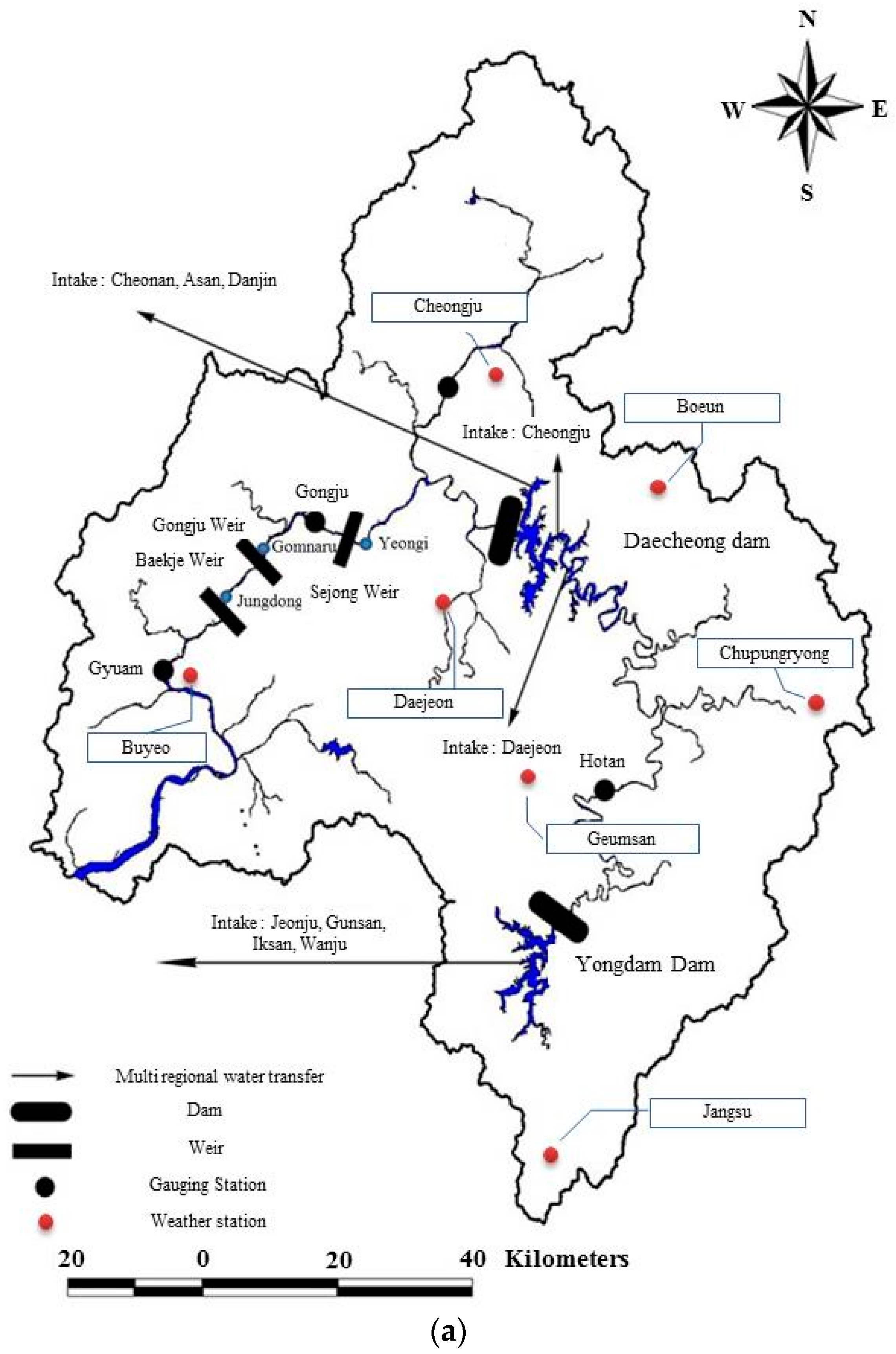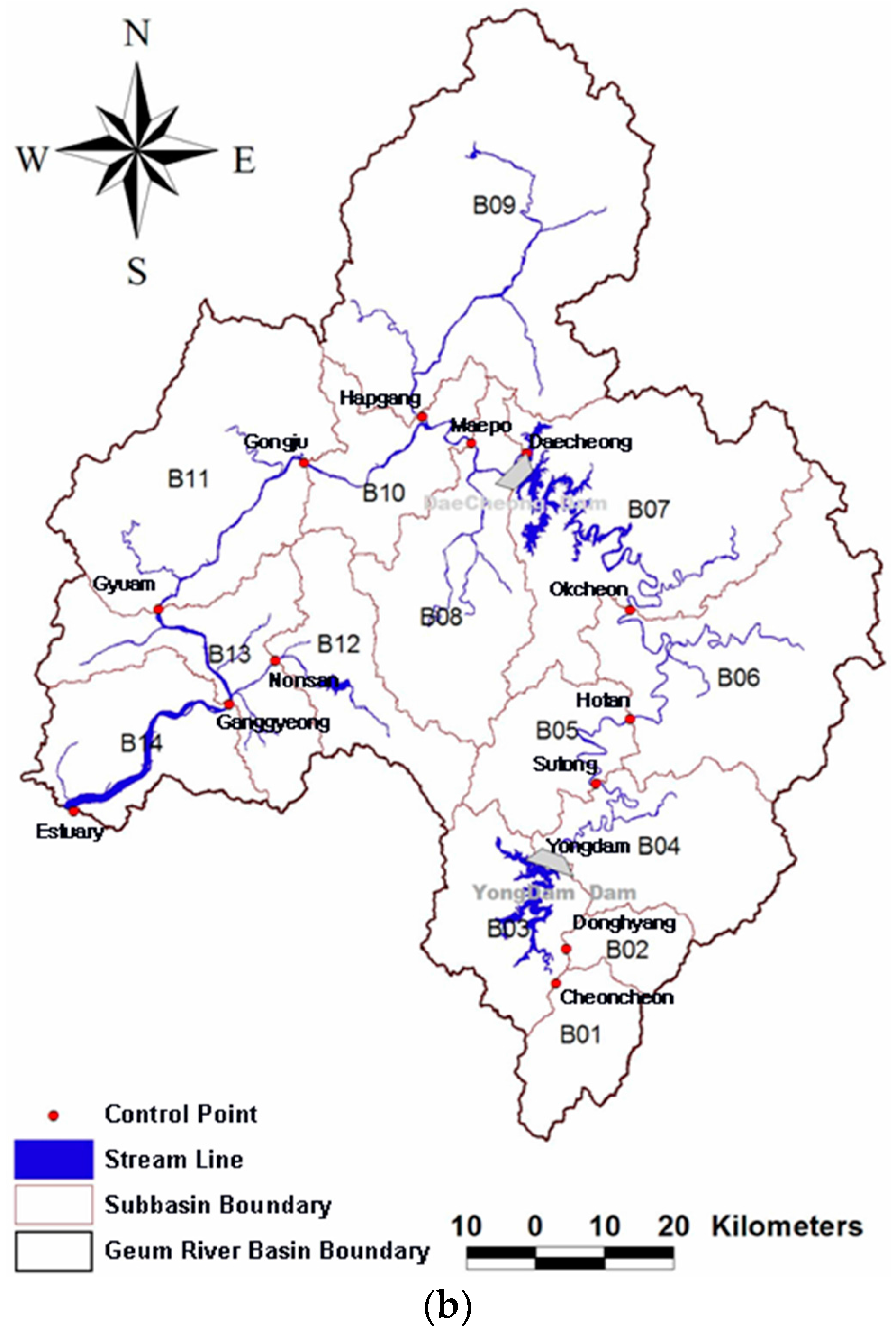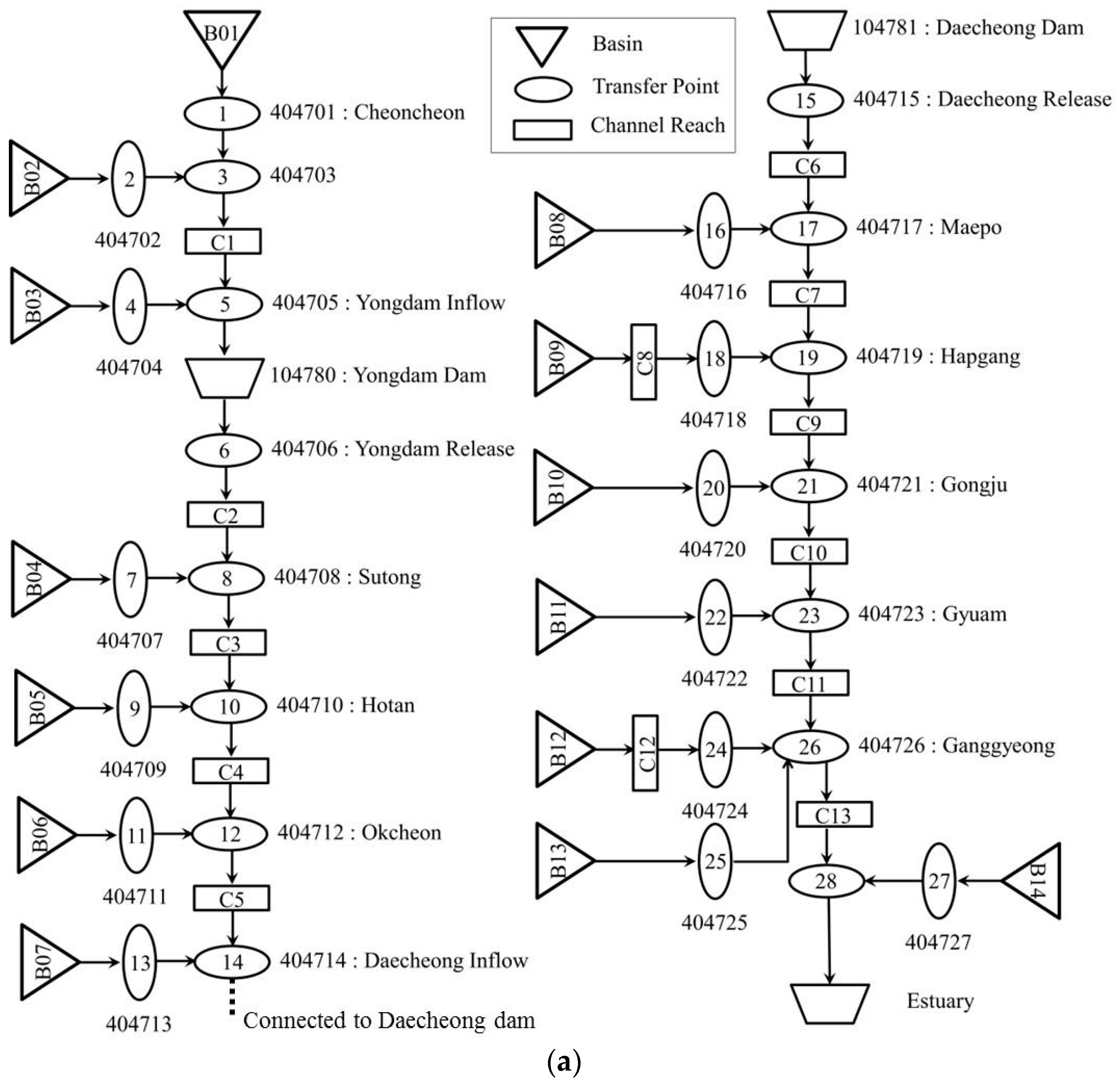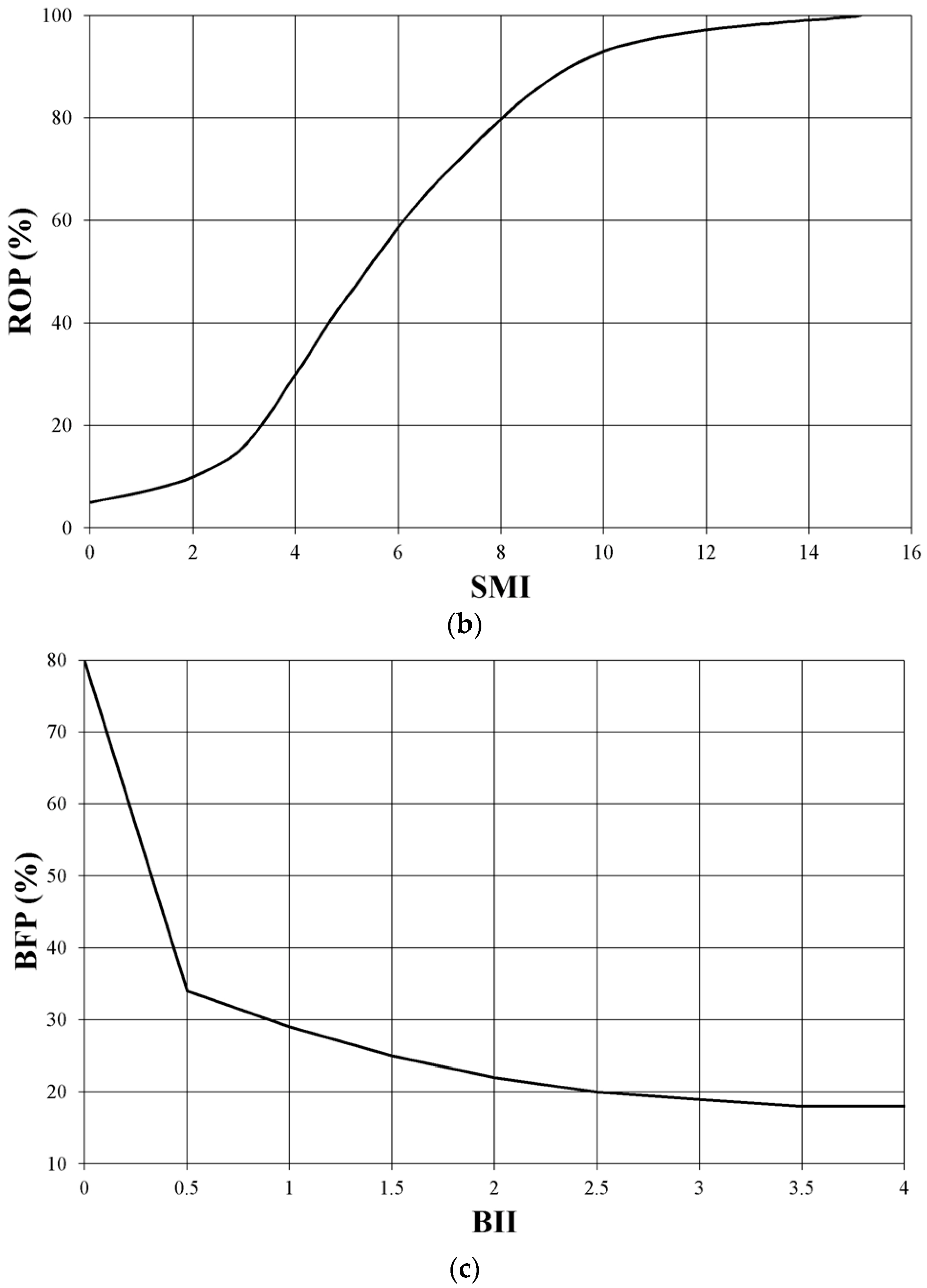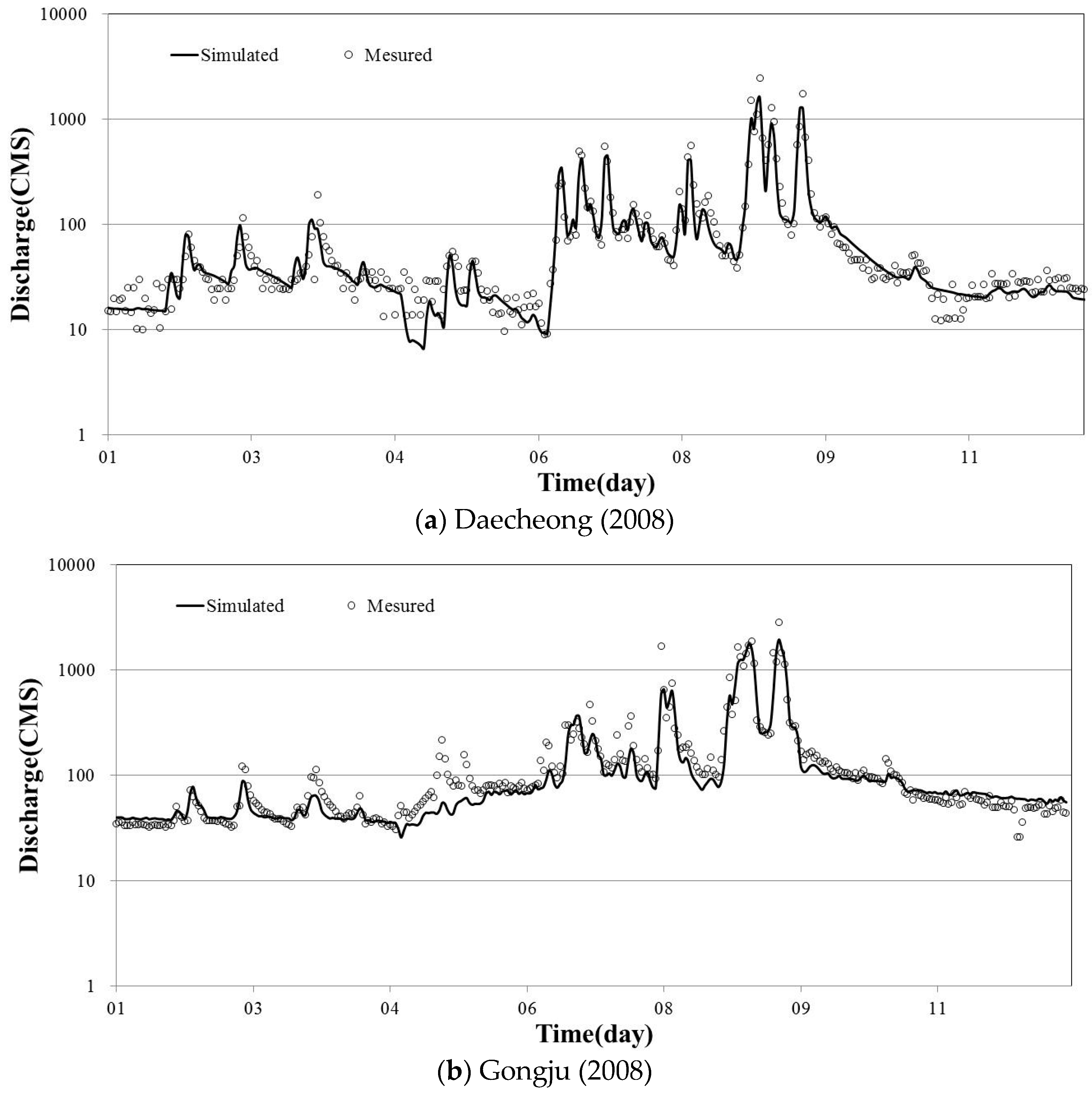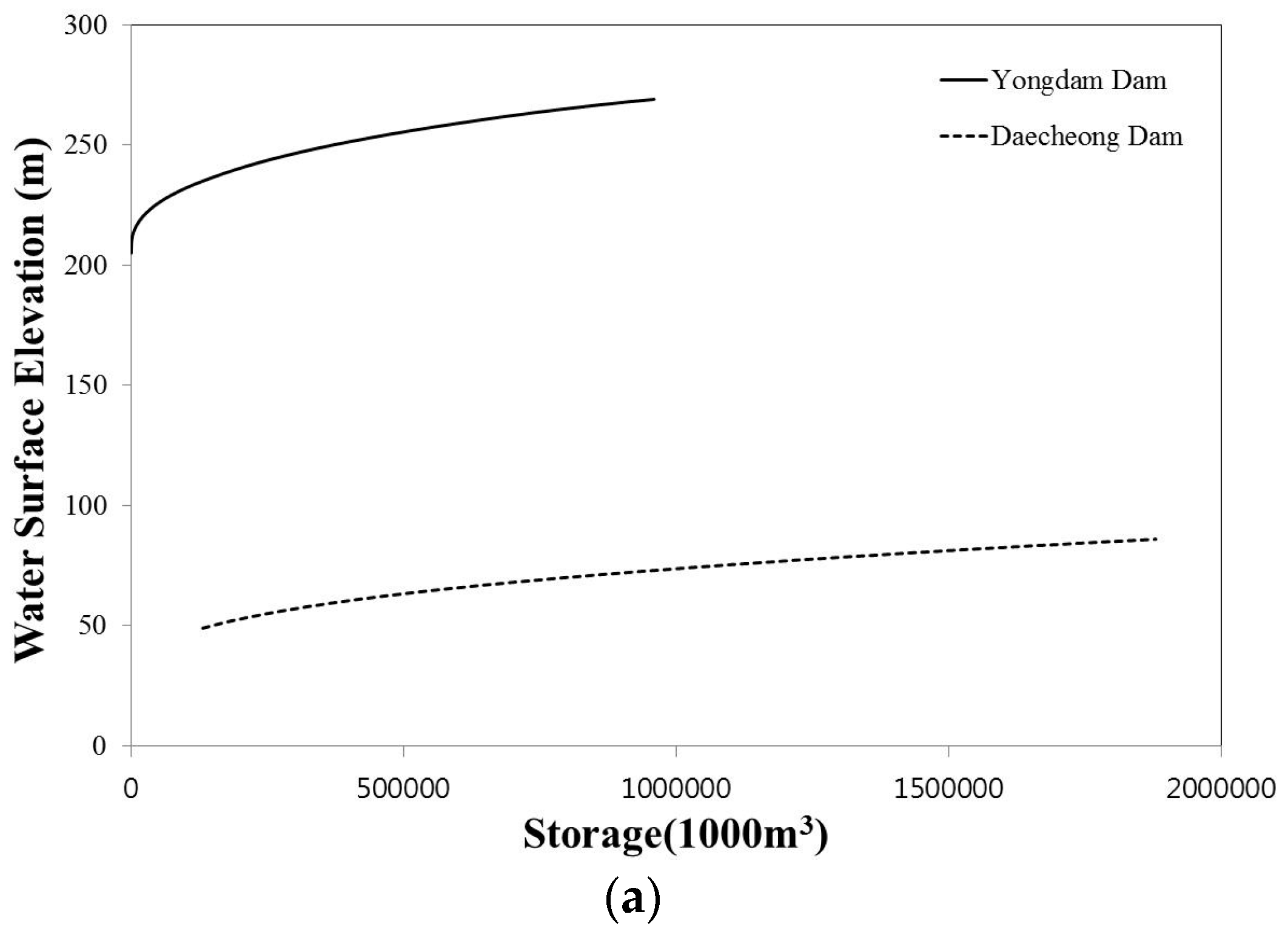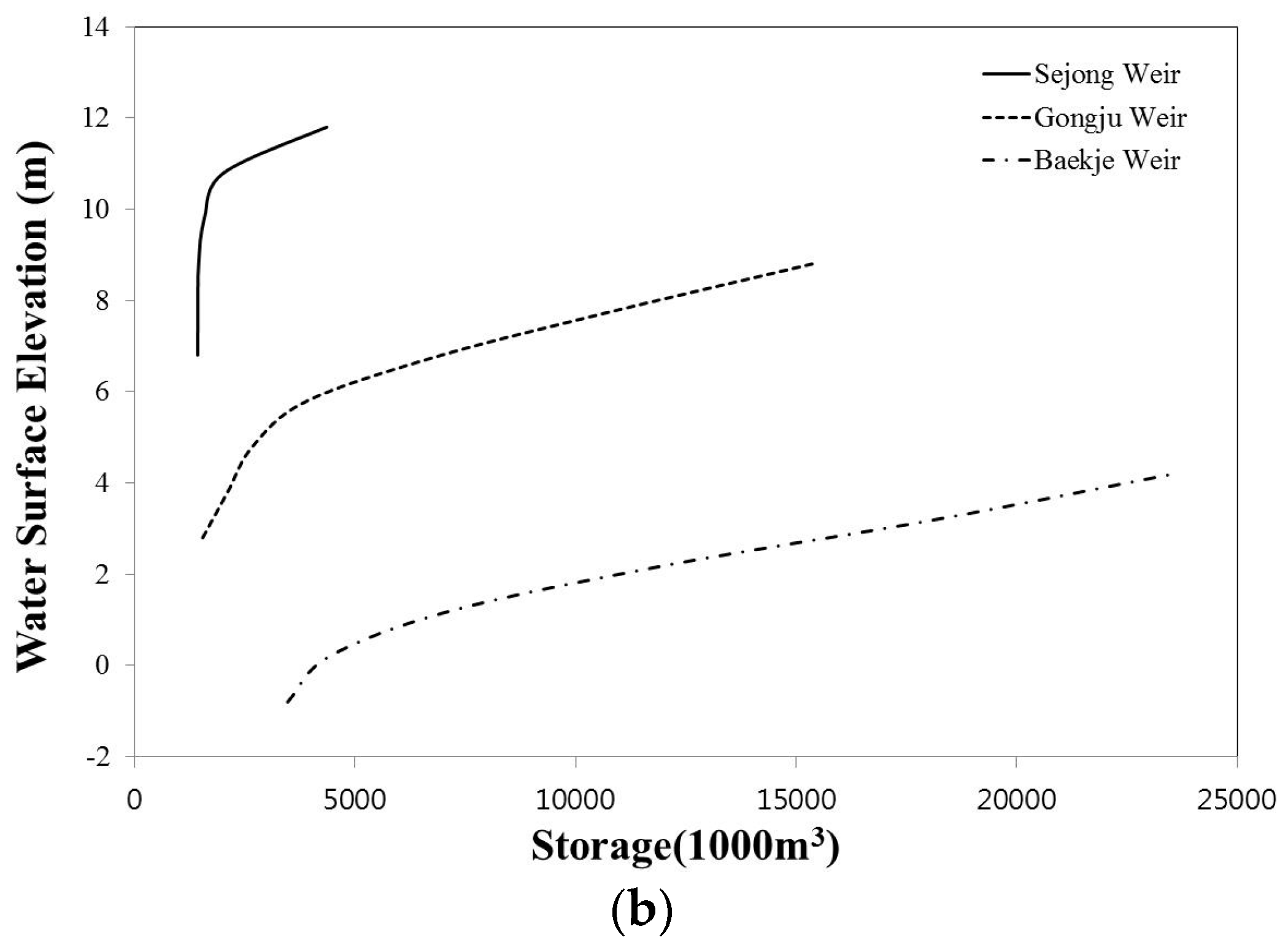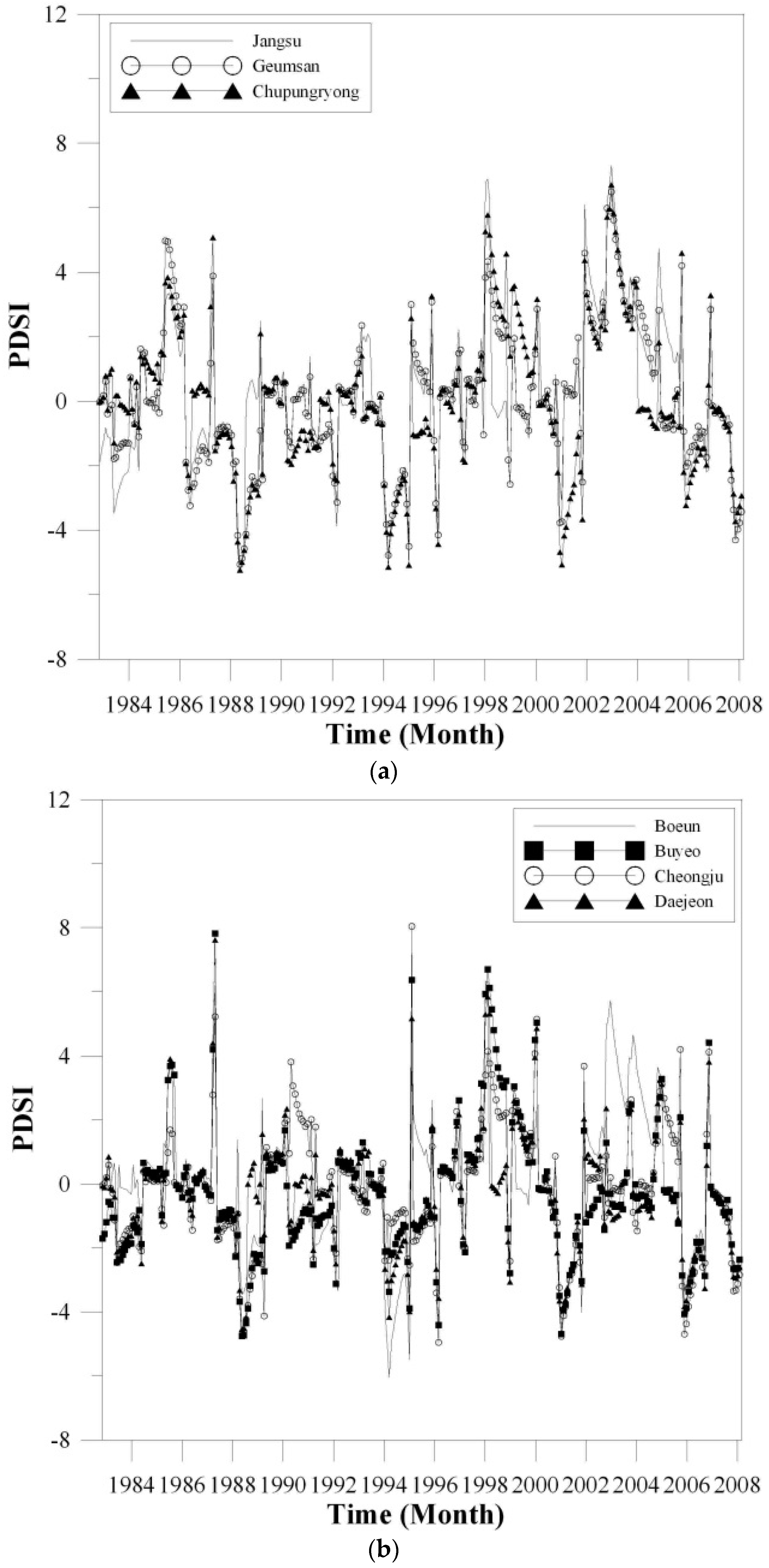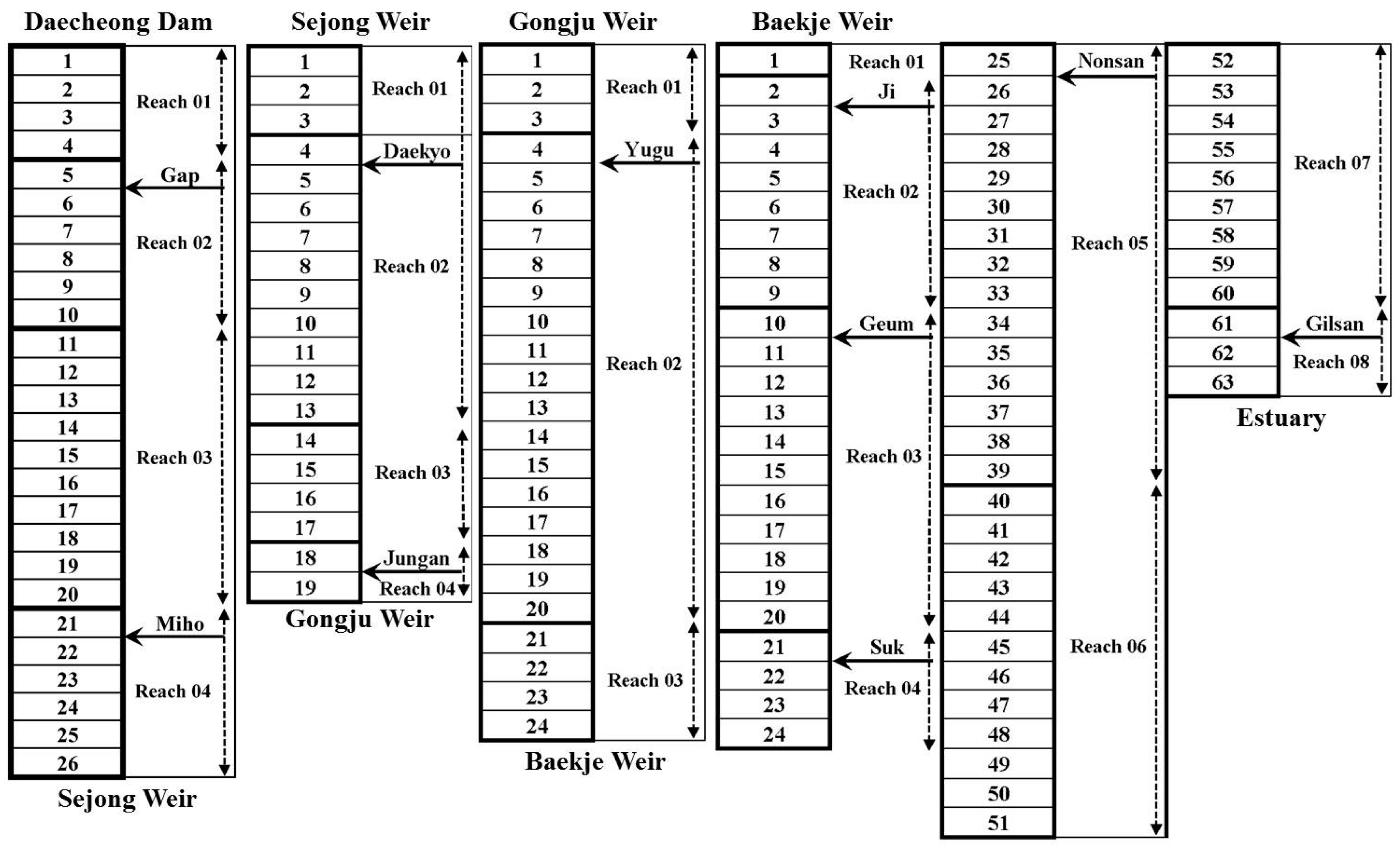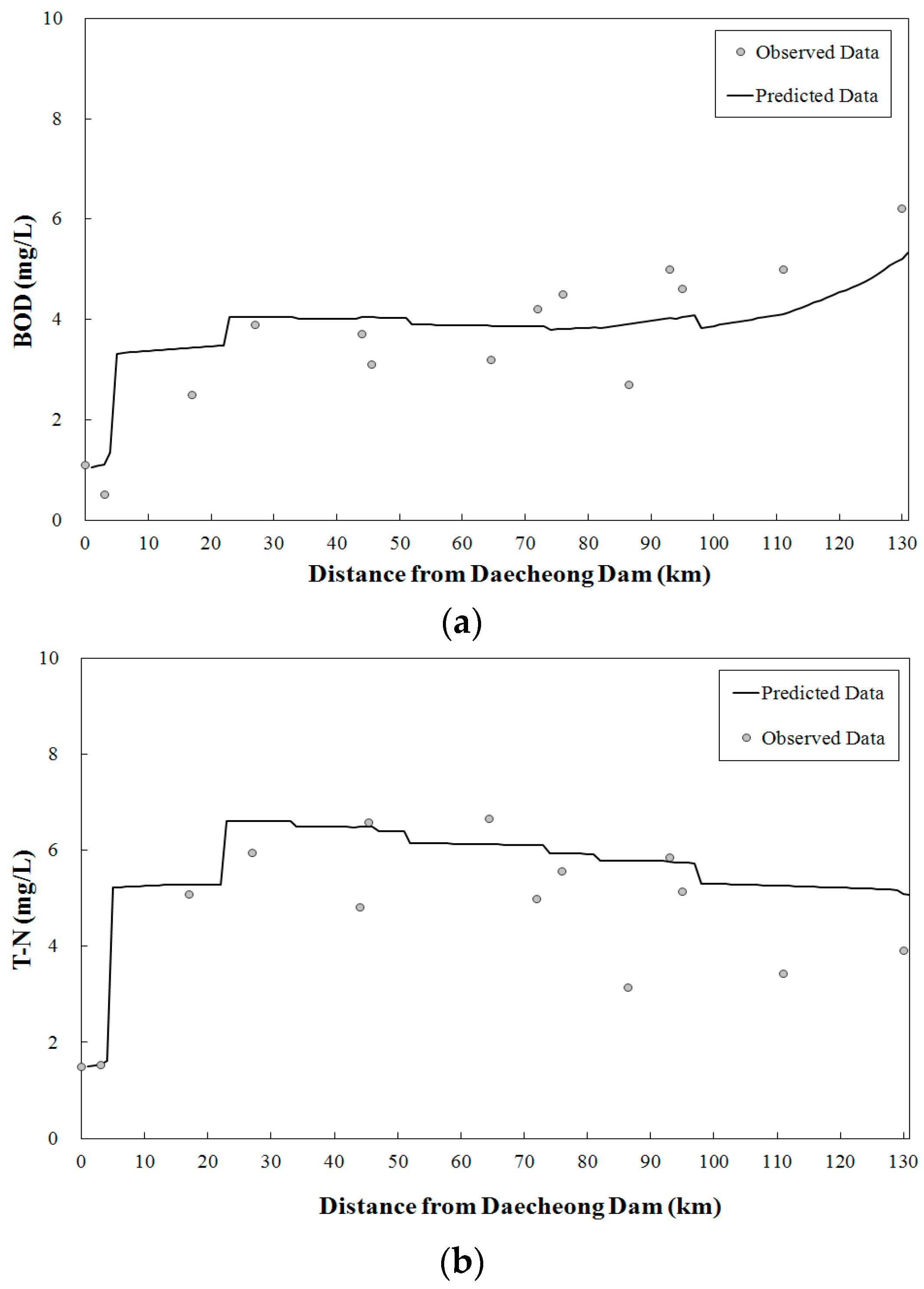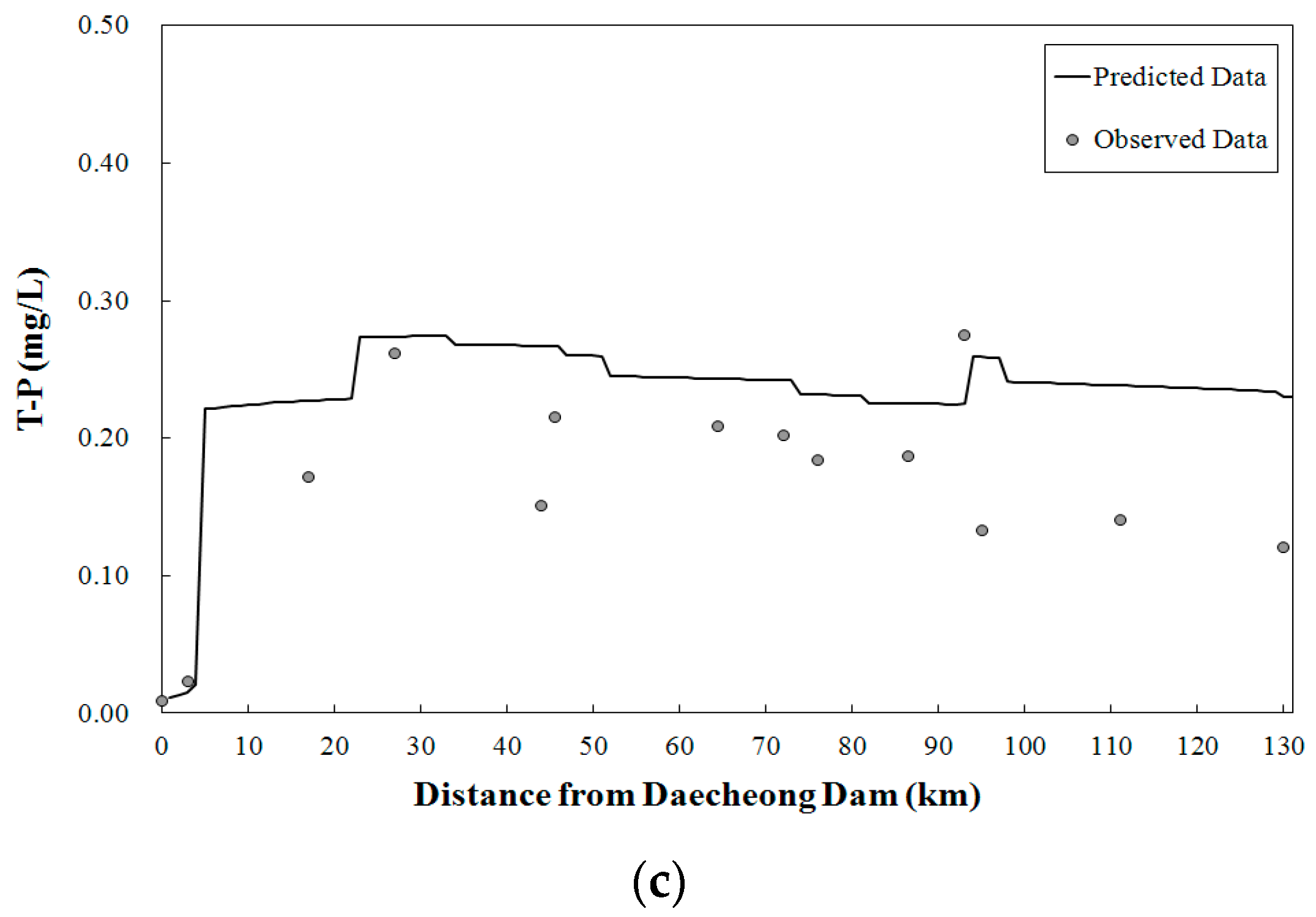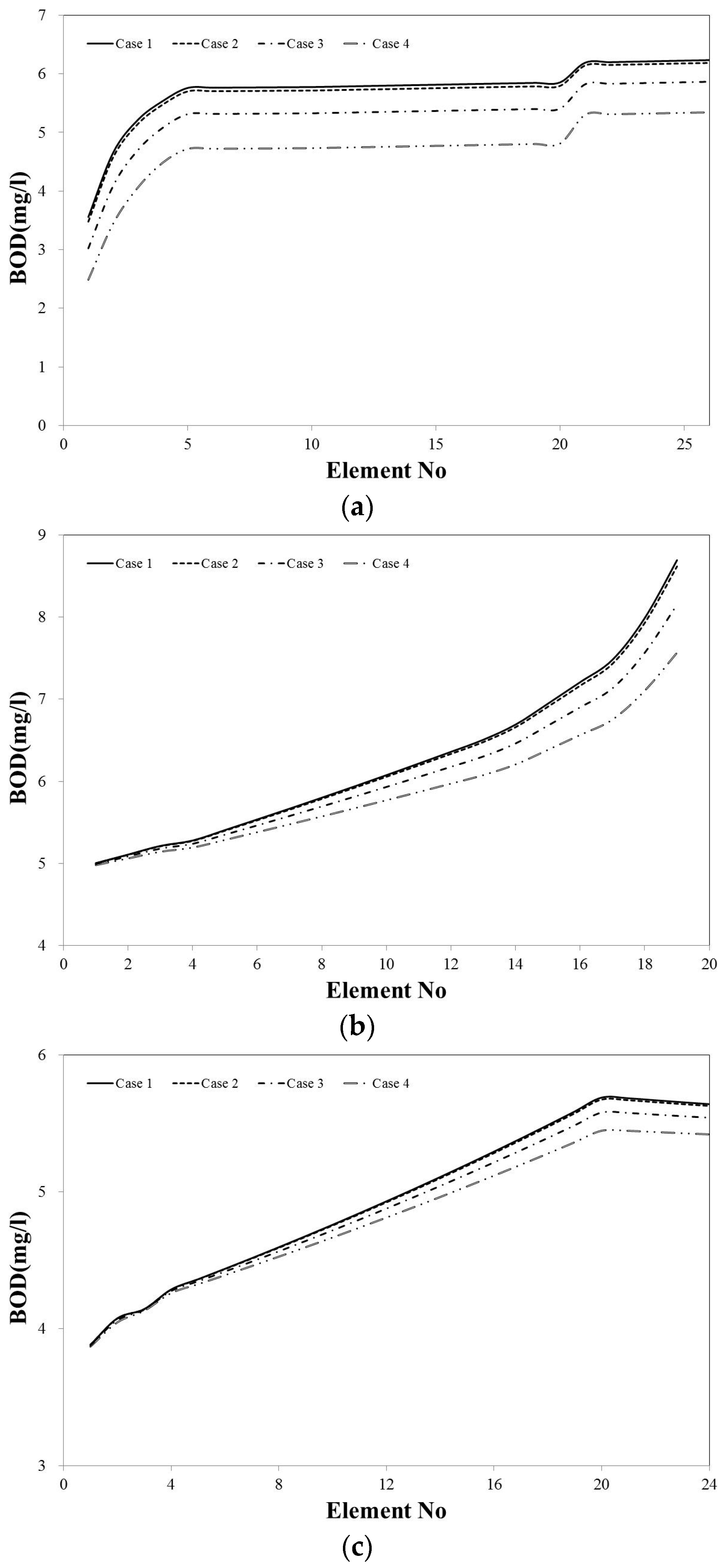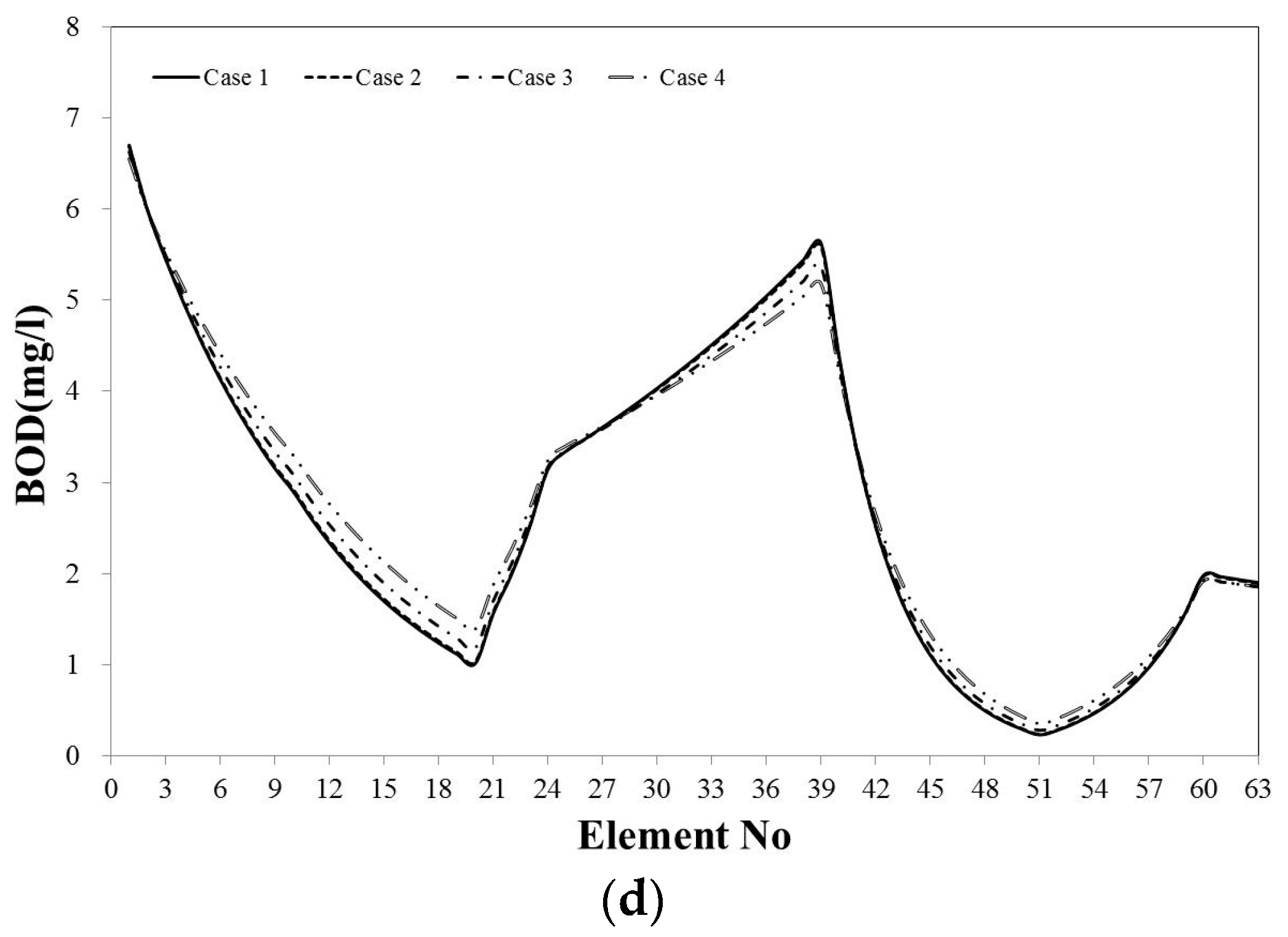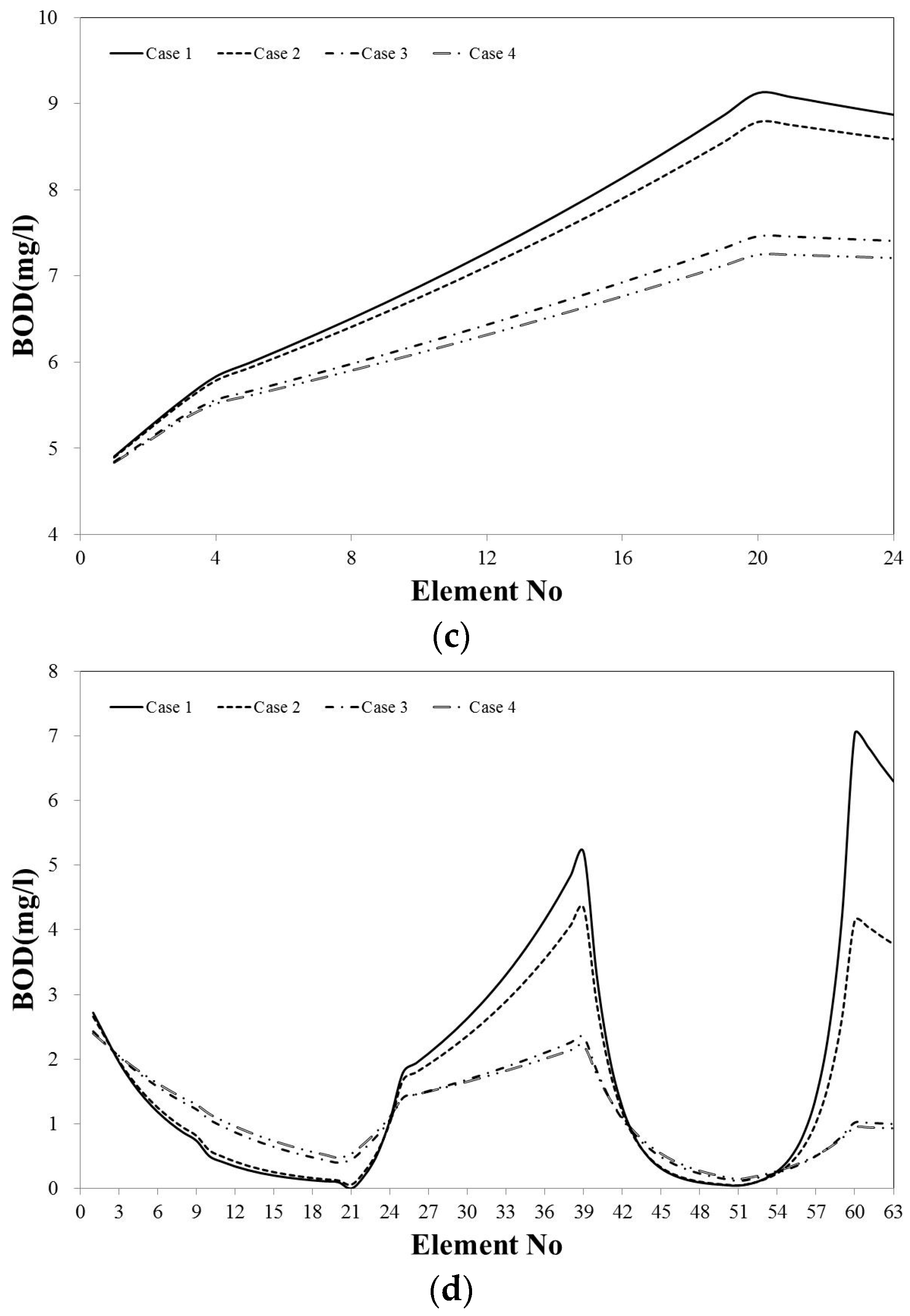This study evaluated the downstream flux depending on the operational method applied to each irrigation facility by calculating the runoff at each point. Water use in the Geum River Basin was evaluated: (a) using a rainfall–runoff model; (b) by applying the calculated runoff to a reservoir operation model; and (c) by examining the variation in the downstream water quality due to the operation of an irrigation facility. For the calculation of runoff, water use and intake in the dam are not considered in the HEC-ResSim model, although water use in each small watershed is considered. To eliminate the discharge features that have changed since 2009, when the Four Rivers Restoration Project was implemented, discharge events that occurred prior to the project were examined. Runoff data over the 25-year period from 1984 to 2008 were calculated with the US Army Corps of Engineers (USACE)’s SSARR (Streamflow Synthesis And Reservoir Regulation) model, and the rate of inflow to each irrigation facility was calculated using the area rate based on the calculated runoff.
3.1. Estimation of Impounded Runoff
The SSARR model was employed to calculate the runoff [
22]. The model was used to improve the GUI (Graphic User Interface) program, which is Windows-based and was developed by the USACE in 1956. This model has been successfully applied to large rivers, such as the Columbia River in the USA [
23], the Mekong River in Vietnam [
24], and the Bocheongchun Basin [
25] and the Geum River Basin [
26,
27,
28,
29,
30] in Korea. The model was selected as the precipitation–discharge calculation program of the river discharge management system [
31], which was implemented for water management purposes after the Four Rivers Restoration Project.
The target area in this study is the Geum River Basin, one of the basins affected by the Four Rivers Restoration Project, where field investigations have been underway for several years to acquire reliable floodgate data. To simulate discharge, the basin was divided into 14 small watersheds, and a schematic of the established SSARR model is shown in
Figure 1b and
Figure 3a. The parameters of the model consist of values established through research by Ahn et al. [
29,
30,
32]. The calculated parameters, including SMI–ROP (soil moisture index-runoff percentage) and BII–BFP (baseflow infiltration index-baseflow percentage), had to be calibrated to be used as initial parameters at the time of simulation in the form of graphs (
Figure 3b). The sum of precipitation and snowmelt amounts is divided into soil water and runoff according to the SMI. The SMI measures the rate of runoff according to the condition of the soil, but it does not contribute to runoff, because soil moisture is removed only by evapotranspiration. The runoff amount can be classified into direct runoff and baseflow using the Baseflow Infiltration Index (BII).
In this study, it is assumed that calibration of the calculated parameters over the period of one year can produce initial parameters at the time of simulation. Modeling and analysis procedures start with the collection of input data, including rainfall, temperature, type of water supply, intake volume and dam discharge. Rainfall–runoff relations for each divided basin are characterized by these parameters, and then corrected by comparing estimated runoff results and observed runoff results.
Figure 4 shows the calibration results of SSARR for the Gongju gauging station to enable comparative analysis of the observed and simulated values. The SSARR model showed that the fitting was in good agreement between measured values and the developed model for runoff.
Statistical bias is defined as the difference between the parameter to be estimated and the mathematical expectation of the estimator. The root-mean-square error (RMSE) is a frequently used measure for the differences between values (sample and population values) predicted by a model or an estimator and the actually observed values. The RMSE depends on the scale of the dependent variable. It should be used as a relative measure to compare forecasts for the same series across different results. The smaller the error, the better the forecasting ability of that model according to the RMSE criterion. These individual differences are also called residuals, and the RMSE serves to aggregate them into a single measure of predictive power. The Nash-Sutcliffe model efficiency coefficient (NSEC) [
33] is used to assess the predictive power of hydrological models. NSEC can range from
to 1. An efficiency of 1 (NSEC = 1) corresponds to a perfect match of modeled discharge to the observed data. An efficiency of 0 indicates that the model predictions are as accurate as the mean of the observed data, whereas an efficiency less than zero (
) occurs when the observed mean is a better predictor than the model. The United States Geological Survey (USGS) reported that the Cedar River Basin model is meeting the criteria of NSEC greater than 0.5, and is a good fit of streamflow conditions for the calibration period [
34]. The Theil inequality coefficient is such that it will always lie between 0 and 1. If TIC = 0,
for all forecasts and there is a perfect fit, if TIC = 1 the predictive performance is as bad as possible. The three corresponding equations are shown below.
where
represents the observed values,
are the modeled values at time/place
i, and
are the average observed values.
Satisfactory model efficiency can then be established depending on the number of times (
Nt) that the observations variability is greater than the mean error. If the mean model error is represented by the RMSE and the variability of the observations is given by their standard deviation (SD), SD and
Nt are expressed as:
If the value of
Nt is higher than 2.2 and the value of NSEC is higher than 0.90, then it can be interpreted that the model performance is very good [
35], as shown in
Table 1. As shown in
Table 2, in the case of the Daecheong Dam, RMSE and NSEC were calculated as 15.9–86.1 and 0.7–0.9, and TIC and
Nt were calculated as 0.11–0.36 and 0.69–2.99, respectively. In the case of the Gongju Weir, RMSE and NSEC were calculated as 41.6–159.2 and 0.5–0.9, respectively, and TIC and
Nt were calculated as 0.16–0.25 and 0.7–1.52, respectively, suggesting “Good” and “Very Good” model performance, respectively.
For the runoff analysis, various hydrologic input data were applied, including precipitation, temperature and type of water, while dam discharge flow and intake flow were excluded in the HEC-ResSim model. For the calculation of runoff, events over the 25 years from 1984 to 2008 were analyzed, and the runoff results at major points were calculated with the SSARR model for use as input data in the HEC-ResSim and Qual2E models.
3.2. Dam-Weir Operation
Before construction of the Daecheong and Yongdam Dams, the Geum River was assumed to be in a natural state, whereas afterwards, the physical and hydrologic characteristics of the river changed due to the construction of the dams. Following the construction of the Sejong, Gongju and Baekje Weirs under the Four Rivers Restoration Project, additional changes ensued.
Figure 5 shows the relationship between the water level and the storage capacity of the dams and weirs.
By reducing uncertainty in reservoir inflows, operators can allocate less reservoir space for flood storage and increase the water provided for instream flow [
36]. The control point for the operation of the irrigation facility was selected as the gauging station point of Gyuam downstream of the Daecheong Dam, where the correlation of water-level flux is relatively well established. In the area where the Yongdam and Daecheong multifunctional dams are located, the Sejong, Gongju, and Baekje Weirs have only recently been constructed. Koh et al. [
37] established the K-MODSIM program for Sutong point with three scenarios, depending on the existence of the Yongdam Dam, and these included: (a) a scenario for Gongju point in which both Yongdam Dam and Daecheong Dam are nonexistent; (b) a scenario in which only Daecheong Dam exists; and (c) a scenario in which both Yongdam Dam and Daecheong Dam exist. K-MODSIM was developed by K-Water by modifying the source code of the MODSIM model originally developed by Colorado University. MODSIM 8.1, the most recent version of MODSIM, was developed for application with the unique conditions and water planning and management issues facing Korea.
This study converted the flux calculated by the SSARR model to the area ratio in order to calculate the flux for HEC-ResSim, as shown in
Table 3. In order to apply the results of the SSARR model to the input conditions of the HEC-ResSim model, the transfer point results as shown in
Figure 3a were used. Thus, 404,705 in
Table 4 is the Yongdam Dam inflow calculated by the SSARR model. The specification, operating water level, reservoir capacity and water supply plans of the dams and multifunctional weirs applied to the model are shown in
Table 4, and are referenced in the Dam Operation Manual [
38].
HEC-ResSim model was carried out before and after construction of the multifunctional weirs. Generally, control discharge and flood discharge were calculated by considering downstream demand and by satisfying water level requirements of the dam under general operating conditions. Discharge control ensures that the water level does not exceed the normal pool level within the range of reservoir discharge capacity and stream discharge capacity at the downstream control point. If the water level in the reservoir falls below the minimum level due to excessive water usage, the discharge terminates. Flood discharge is determined considering the specified discharge that does not cause downstream damage, although if the water level of the dam rises continuously, the amount of water required to cause a drop in the water level must be discharged for the safety of the dam.
By operating multifunctional weirs, the water level can be maintained at a constant level, unlike during dam operation. Ahn et al. [
14] reviewed the directional behavior of downstream flow, which maintains the water level (target water level) for landscape creation. An excessive amount of water is discharged through fixed weirs and additional water shortage is caused by gate operations, if downstream demand is not met. Because discharge through a fixed weir runs parallel to the discharge through fishways and other small hydropower systems, stream discharge capacity insufficient for the fixed weir is supplemented. Unlike dams, multifunctional weirs do not have a freeboard (the vertical distance between the top of the dam and the full supply level of the reservoir). If a freeboard is established in the multifunctional weir model, simulations for normal operating condition are not feasible, because additional reservoir capacity has been created. Therefore, because the freeboard is equivalent to the controlled water level established in the multifunctional weir model, virtual reservoir capacity is eliminated and must be replenished by overflow through a fixed weir. When inputting the specifications of the multifunctional weir, the simulation must be carried out with only a movable weir, primary floodgates, including sluice gates, and fishway gates. Currently, the length and width of the fixed-weir section must be input precisely, and the overflow volume through the fixed weir is calculated by the model.
The operating water levels of the dams and weirs are shown in
Table 4. The operating water levels of the dams and the reservoirs correspond to the minimum water levels, while the operating water levels of the multifunctional weirs correspond to the water levels set for drought conditions before weir construction. The constant flux at Gyuam point was increased as much as possible through the coordinated operation of the structures. Although discharge assumes priority, both the independent operation of the dams and the relatively simple integrated operation can be easily simulated in the HEC-ResSim model using the serial operation rule, parallel operation rule, and simple discharge rule. However, the operating rules used in this simulation cannot be easily established in the case of the complicated dam connection structures used in Korea.
Accordingly, this study prioritizes operating rules and general operating rule settings, which can be divided into the establishment of the model and operating rule settings (
Figure 6). Dam operation is similar to the operating conditions under which the water supply capacity of existing dams was investigated [
39], and the operating rule is applied based on the rules suggested by Ahn et al. [
14].
In the case of a tandem operating rule, discharge of the downstream dam is satisfied through coordinated operation, while maintaining the same storage capacity of the dam and the weir. Next, a downstream control function rule satisfies downstream demand, considering effective water storage, by allocating large discharge to the side where effective water storage is large and small discharge to the side where the effective water storage is small. In this study, we applied the optimized operating rules as shown in
Figure 6.
Korea Institute of Construction Technology (KICT) (1994) proposed a reliability-based assessment method to improve water supply capacity assessments of multi-purpose dams [
40]. Since an annual water supply plan relatively underestimates the water supply, the KICT method was selected for calculations of annual water supply reliability as shown in Equation (6):
where,
is the total number of analyzed years, and
is the number of satisfied years.
Reliability (
) is defined as the probability that the system will properly provide the water supply during time period
t, and it can be expressed as shown in Equation (7). Risk (
) is defined as the probability that the water supply will not satisfy water demand in time period
t, and it can be expressed as shown in Equation (8). The criteria used in the reliability analysis for the design and operation of the water resource system are divided into frequency-based reliability values, which show the proportion of the total period during which water shortages occurred, and quantitative reliability levels, which show the proportion of water shortages in relation to the total water supply; the relevant equations are as follows:
where
α is the reliability,
S is the satisfied water demand,
is a risk degree, and
F is the water shortage state.
Briefly describing a system optimization method, the safety degree for water shortage used to assess water supply was set as 97% calculated from Equation (6), meaning water shortage occurs for only one year in the total 25 years of discharge events. For calculation of runoff using the SSARR model, events over the 25 years from 1984 to 2008 were analyzed.
There are many operating rules applicable to the HEC-ResSim model.
Figure 6 is the rule that can supply the maximum water. The optimal operation rule proposed in this study is to find the operation rule that satisfies Equation (6), and at the same time, it is when the maximum water supply is possible as shown in
Figure 7.
The irrigation water (residential/industrial/agricultural) and the maintenance water supplies were fixed (constant amount), and the amount of discharge from the dams and weirs was adjusted. The optimization water supply in the coordinated operations means the maximum amount that can be supplied in the water system including the maintenance water of the river.
The dam-weir operation scenario created flux data for the Gyuam gauging station, which are divided into four cases: (Case 1) no dam-weir; (Case 2) independent operation of Yongdam and Daecheong Dams: (Case 3) coordinated operation of Yongdam and Daecheong Dams; and (Case 4) coordinated operation of Yongdam and Daecheong Dams and Sejong, Gongju and Baekje Weirs.
There are three operating rules that are important for the HEC-ResSim model: (a) the release function rule; (b) the tandem operating rule; and (c) the downstream control function rule. The release function rule is applied when discharges are carried out in accordance with planned discharge flow without considering their impact on downstream reservoirs. When hydraulic structures are interconnected in series, the tandem operating rule is applied to the upstream dam, and the hydrological structures subject to this rule satisfy the demand from downstream by managing the reservoir capacity based on the data from equivalent reservoirs. When hydraulic structures are interconnected in parallel, the downstream control function rule is applied to the downstream reservoirs to meet the downstream demand considering the effective storage capacity of the hydraulic structure.
In Case 1, natural streamflow was estimated because an irrigation facility was not included in the operating scenario. In the case of independent operation of the dams (Case 2), the dams were simply interconnected using the release function rule. In Case 3, under coordinated operating conditions, the dams, the multifunctional weirs, and the Gyuam gauging station were interconnected, as shown in
Figure 6a. Coordinated operation between the dams and multifunctional weirs (Case 4) interconnected the dams, multifunctional weirs and the Gyuam gauging station as shown in
Figure 6b. For the coordinated operation of the Yongdam, Daecheong Dams and the Sejong, Gongju, and Baekje Weirs, maintaining a flux of 17.1 m
3·s
−1 at the Gyuam gauging station was satisfied, and the additional discharge, considering inflow at Gyuam, was calculated. To assess the water supply capacity for each case, the minimum planned number of dams and the maintenance flows at major points in the river system must be satisfied, the amount of water needed for irrigation and maintaining a minimum water level behind the dams is fixed, and the amount of residential/industrial water is adjusted.
The results for Diversion (A), Release (B) and Diversion (C) for Cases 2–4 are 9.9 m
3·s
−1, 5.0 m
3·s
−1, and 29.4 m
3·s
−1, respectively. Flow rate is often referred to as “
Q,” and the exceedance value as a subscript number, such that
Q95 means that the flow rate is equaled or exceeded for 95% of the time. The results of the flow duration curve (FDC) at the Gyuam gauging station at a drought water level of
Q95 are as follows (
Figure 7): Case 1—12.2 m
3·s
−1, Case 2—16.2 m
3·s
−1, Case 3—30.6 m
3·s
−1, and Case 4—35.1 m
3·s
−1. Compared with the flux of 16.2 m
3·s
−1 measured under independent dam operating conditions (Case 2), an additional flux of 14.4 m
3·s
−1 is supplied by the connected operation of the dams (Case 3), and an additional flux of 18.9 m
3·s
−1 is supplied by the connected operation of the dams and weirs (Case 4). In order to supply water resources effectively, each operating rule applied in the study through coordinated operation of the dams and weirs. Achieving greater efficiency in water control is possible during the dry season when constant flux at the Gyuam gauging station is maintained by the coordinated operation of the dams and weirs, as shown in
Figure 7.
The method simply uses the retained water level of the dam and the reservoir for the calculation of the impounded runoff index (calculated as reservoir capacity divided by mean annual runoff of the river), as suggested by Batalla et al. [
41]. The impounded runoff index explains variations in flow regime characteristic factors for the dams in this study. The cumulative maximum effective reservoir capacity in the corresponding period is divided by the average annual runoff in the Geum River Basin to evaluate the variation in retention volume during each season.
Irrigation facilities constructed in the Geum River Basin were investigated, as shown in
Table 5. The annual average runoff was calculated using inflows from 1967 to 2006 (long-term water resources master plan, 2006–2020) considering an annual water consumption of 5771.8 million m
3. Although the water supply capacity increased according to the improved impounded runoff index since the Daecheong Dam was constructed in 1981, Lee et al. [
42] described the calculated results of the flow regime coefficient for the Geum River Basin as follows: “Since the impounded runoff capacity of Daecheong Dam is relatively small, it has not largely contributed to the improvement of flow regime during floods and this implies the necessity of new supplementary dam construction at the main stream of Geum River Basin”. The flow regime coefficient is the ratio of the minimum flow rate to the maximum flow rate measured at any point in the stream during one year as shown in Equation (9). If
is close to 1, the flow regime is a good river. The larger the value of
, the greater the fluctuation of the flow rate.
Based on this analysis, the impounded runoff index was increased to 0.292 after the Yongdam Dam was constructed in 2001. If the additional retention volume of the multifunctional weirs is used, the impounded runoff index can be increased to 0.297, and a potential water supply of 1/3.37 (or 29.7%) of the runoff in the Geum River Basin is retained.
3.3. Drought Index
Droughts represent long-term natural disasters, whereas floods represent short-term natural disasters, whose start and end dates cannot be predicted. To appropriately define a drought, Dracup et al. [
43] expressed the need for a distinct classification of factors related to droughts. Palmer [
44] defined a drought as an irregular long-term water shortage, whereas Wilhite and Glantz [
45] defined it by classifying the meteorological, hydrologic, agricultural, social and economic aspects of droughts based on numerous studies. Jeong [
46] suggested that although various definitions of drought are based on multiple viewpoints from different fields, such as meteorology, agriculture, water resources, sociology and economics, a drought can generally be defined as a water shortage caused by the lack of rainfall over an extended period of time.
The general method for quantitatively evaluating a drought involves calculation of drought indices. Although numerous methods for evaluating drought severity based on indices exist, these indices are typically expressed as factors contributing to drought. The drought indices generally used in domestic and global studies are the Standardized Precipitation Index (SPI) and the PDSI. The SPI, which was developed by the National Drought Mitigation Center (NDMC) in the USA, calculates not only various drought indices for various time periods based on the probability of precipitation for a certain period of time, but also predicts droughts and estimates the drought severity. The PDSI, which was developed by Palmer [
44], has been widely used to determine when to grant emergency drought assistance by the USA Department of Agriculture (USDA). The PDSI, which is based on climate, considers the variation in temperature and precipitation that affects droughts and is highly reliable in areas where the topography is uniform and flat. Dai [
47] provided a detailed description of the PDSI and studied various drought characteristics and trends using the PDSI.
Palmer defined the range of wet and dry conditions according to the drought index, as shown in
Table 6. In this study, monthly drought severity and drought indices were calculated using the Palmer method, based on precipitation and temperature data from seven weather observation stations located along the Geum River Basin for the period from 1983 to 2008, as shown in
Figure 1a. Floodgate data were obtained from each weather observation station. The drought analysis was performed using existing data from the National Weather Service. Drought events were reported in Korea in 1973, 1977, 1982, 1988, 1994, 1995, 2001, 2008, 2012 and 2013 [
48,
49,
50]. The calculated results of the PDSI for each weather observation station are shown in
Figure 8. Although the PDSI exhibits differences amongst the drought years, the results indicate the overall tendency and severity of the droughts are similar. Because the duration of the existing drought coincides with the study period, and the severity and frequency of droughts in the Geum River Basin does not show significant differences, the 2008 drought was selected as the drought period for this study.
3.4. Water Quality Analysis
Because annual water use is highly dependent on river water intake, and many industrial and sewage treatment facilities are installed and operated on riverfronts in Korea, quality control of the river water downstream of the dam is critical. Optimal flow releases, through the turbines of one or more dams, are typically defined as maximizing energy production or value, while meeting water demands (e.g., [
51]). Securing the availability of a sufficient quantity of water through reservoir operation is crucial for ensuring the water quality at major facilities, such as intake stations, because an appropriate level of water quality can be maintained through discharge when the water quality of the river deteriorates under drought conditions. The evaluation of changes in water quality in the watershed due to the multifunctional weirs constructed as part of the Four Major Rivers Restoration Project, and a successful promotion of the total maximum daily load (TMDL) management system, are necessary for an integrated water resource management that considers quantity and quality of the water.
Dam discharge directly influences water quality such as turbidity and nutrient concentrations, although these effects are unusual and are unlikely to occur in most channeled rivers. In this study, the Qual2E model [
52], which integrates water quantity, water quality and reservoir group operation, was used for water quality analysis in the target area. A flowchart of the construction of the Qual2E model, which considers both the main stream and tributaries, is shown in
Figure 9.
Figure 9 shows the structure of the Qual2E model developed in the Geum River Basin. In this study, the Qual2E model is divided into four sections: (1) Daecheong Dam and Sejong Weir; (2) Sejong Weir and Gongju Weir; (3) Gongju Weir and Baekje Weir; and (4) Baekje Weir and Estuary Weir. The section between Daecheong Dam and Sejong Weir is constructed with four reaches and 26 elements. The tributary Gapcheon joins at element No. 5 and Mihocheon joins at element No. 21. The section between Sejong Weir and Gongju Weir is constructed with four reaches and 19 elements. As tributaries, Daegyocheon joins at element No. 4 and Jeongancheon joins at element No. 18. The section between Gongju Weir and Baekje Weir is constructed with three reaches and 24 elements. The tributary Yugucheon joins at element No. 4. The section between Baekje Weir and the Estuary Dam is constructed with eight reaches and 63 elements. As tributaries, Jicheon joins at element No. 2, Guemcheon joins at element No. 10, Seokseongcheon joins at element No. 21, Nonsancheon joins at element No. 25, and Gilsancheon joins at element No. 61. The upstream boundary condition for the Qual2E model was established using the runoff at the Daecheong Dam and Sejong, Gongju, and Baekje Weirs calculated by HEC-ResSim for the drought event of 2008. The basin runoff calculated in SSARR was applied to the Qual2E model as a lateral boundary condition. For the water quality at the Daecheong Dam, and Gapcheon, Mihocheon, Daegyocheon, Jeongancheon, Yugucheon, Jicheon, Guemcheon, Seokseongcheon, Nonsancheon and Gilsancheon tributaries, the monthly average water quality values observed from 2007 to 2012 were applied. For the water quality at Sejong, Gongju, and Baekje Weirs, the monthly average water quality values observed in 2010 and 2011 at Yeongi, Gomnaru, and Jeongdong, which are located upstream from the respective weirs after the Four River Restoration Project, were applied. Water quality parameters such as water temperature, Biochemical Oxygen Demand (BOD), Chemical Oxygen Demand (COD), tidal current, nitrogen, phosphorous, and Dissolved Oxygen (DO) were considered. The parameters used by Ahn et al. [
32] were used for model correction, as shown in
Figure 10, which shows the calibration results of the Qual2E for three water quality parameters, including BOD, Total Nitrogen (TN) and Total Phosphorus (TP), and which provide comparative analysis of the observed and simulated values.
Figure 10a–c shows the calibration results of the model by distance from the Daecheong Dam for April 2006, as well as the spatial variation.
The discharge flux of the dams and weirs were calculated by an optimization operation in the previously established HEC-ResSim model, as suggested in
Table 7. The inflow flux of the tributary was calculated by converting the value obtained from the 2008 drought event in the previously established SSARR model to a branch stream to basin area ratio, as suggested in
Table 8. The BOD in the Geum River Basin shows a rapidly increasing trend in April and May when the temperature increases [
53]. The decline in water quality during those months can be attributed to insufficient flux in the stream, because large amounts of water are used for agricultural purposes during the farming season when the effects of nonpoint source pollution by precipitation and increased temperature are dominant. Accordingly, this study performed water quality analysis for each facility in April and May 2008, which corresponds to the occurrence of drought, as shown in the calculated results of the drought index.
